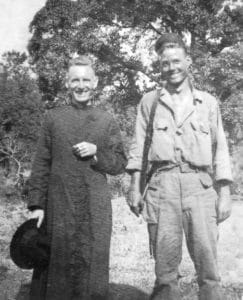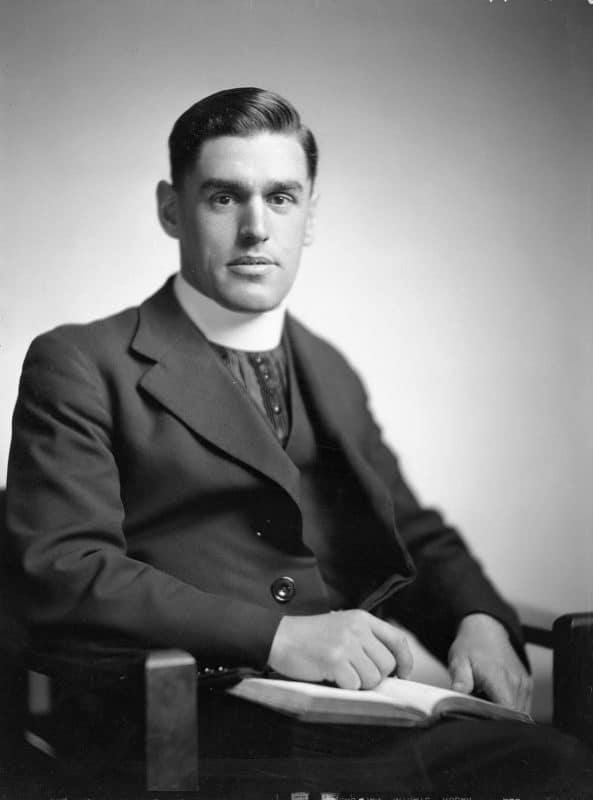by KAREN CORBETT SLOPER
The year was 1943. It was 78 years ago this July, and the date was the 23rd. This day was one of the many frightful days of World War II. On this dreadful day, Rev. Francis Vernon Douglas, a New Zealand Columban priest, was violently seized by Japanese soldiers from his parish church, St Mary Magdalene, in Pililla, on the edge of Laguna de Bay.
The invading Japanese force had occupied the Philippines since the bombing of Pearl Harbor in December, 1941.
Fr Douglas was later seen the following day in nearby Paete, as he was dragged through the town plaza. The town’s people did not know who he was, or where he had come from. The Japanese commandeer announced Father Douglas was a “spy”; and later brought him to the local church, St James the Apostle, where they tied him to a pillar that held up the choir loft in the church. He was then tortured for the next three days.
Fearful of reprisal, the local villagers were unable to show any compassion or offer him any assistance, as they knew full well the brutality of the Japanese military during those days of occupation. As darkness fell after his third day of torture, he was seen being dragged out of the church, and was thrown into the back of a Japanese military truck. He was never seen again.
Father Douglas was remembered by all who knew him. An all-boys, state-integrated secondary school, Francis Douglas Memorial College at Westown, New Plymouth, was built to commemorate his life and heroic death; but as the years passed, memories faded.
Thirty-seven years ago, Patricia Brooks, author of “With No Regrets”, set out on a quest to find some answers. Patricia submitted an article to the New Zealand Tablet, seeking information from anyone who might know what happened to Father Douglas, after he was seen close to death in the back of the Japanese military truck. She also sought answers as to where his remains may be found.
Father Vernon Douglas was a good friend of Patricia’s father, Brian Molloy. They became friends while students at Holy Cross College, Mosgiel.
Upon her dad’s death, old letters that Father Douglas had sent to Mr Molloy prior to his kidnapping, were found. These letters sparked a curiosity within Patricia. Her article in the New Zealand Tablet in 1993 brought forth some of those who knew Father Douglas personally, professionally, and those who did see, and were there.

Kevin Corbett (right) and Fr O’Reilly
Unknown to Patricia, at the time of her tracing the life and disappearance of Father Douglas, an American GI, Kevin Corbett, who spent close to a year in the Philippines during World War II, with the 43rd Cavalry Reconnaissance Troop Mechanised Division, was also writing and putting his thoughts on paper in his book, “The Bamboo Shepherd”.
The story was told to him by Father Hugh O’Reilly, another Columban priest. Kevin did not want the story of the disappearance of Father Douglas forgotten; he wanted this story told and remembered. His book, a fiction, is about what might have occurred.
Recently, Kevin’s diary of his three and one-half years of fighting during World War II was found by two of his children. Kevin arrived in the Philippines in January, 1945.
In his diary, he writes about, March 17, 1945, St Patrick’s Day, usually a day of celebration, both in the USA and Ireland.
This was a day when American GIs rescued two priests, Father O’Reilly and Father Doherty. They had been hiding in the hills near Tanay. They had been relocated there by Filipino guerillas, who had feared for the safety of these two priests, after seeing and hearing of the disappearance of Father Douglas. The two priests lived as hermits for 22 months; eating whatever food the guerillas could provide them.
Father O’Reilly, of the Columban order, was from Dublin, Ireland, and had been in the Philippines for ten years, before, during, and after the occupation of the Philippines by the Japanese. He was assigned to the church in Morang. Father Doherty was from Dorchester, Massachusetts USA, and was assigned to a church in the area.
Neither of the priests had eaten a good meal in a few days. Kevin Corbett offered Father O’Reilly some of his food from his mess gear. Joe Fodale, another GI from Detroit, Michigan, USA, and also from Recon, provided Fr Doherty with something to eat as well.
This began a long friendship between Kevin and Father O’Reilly. The priest shared the events leading up to Father Douglas’s torture and disappearance. He also shared his own near-removal from his church in Morang by the Japanese.
Patricia Brooks was fortunate enough during her research to be able to interview some of those who witnessed the events leading to Father Douglas’ kidnapping. Some witnesses had seen and heard the torture. Others had seen Father Douglas in the back of the Japanese military truck.
Any leads, as to where the Japanese took Fr Douglas, all proved to be nonfactual.
Kevin Corbett, on the other hand, only heard the story second-hand. At the time of Father Douglas’ disappearance, he was on the beachhead on Rendova and the Munda Trail with his Recon Unit, reclaiming the Munda air strip from the Japanese.
Kevin writes in his diary “Father Vernon Francis Douglas, a Columban Father, who on or about the 27th of July, 1943, along the shores of Laguna de Bay of Luzon, Philippines, under the threat
of a sword, gave his life for his friends and the world.”
Kevin never forgot. He was not there, and he did not see; but he always remembered Father O’Reilly’s story. Perhaps many years ago, someone you knew remembered and told you the story about Fr Douglas. Somewhere in your memory, maybe, just maybe, you know the ending?

[…] Rev. Francis Vernon “Frank” Douglas was born in Johnsonville, New Zealand, in 1910. According to Wikiwand, “Douglas trained for the Catholic priesthood at Holy Cross Seminary, Mosgiell. Within a few months of his ordination, at the end of 1934, he applied to join the Missionary Society of St. Columban. He was curate at New Plymouth when he left to join the society at the start of 1937. He was appointed to the Philippines in July 1939.” Father Douglas was never interned, but recently, The New Zealand Catholic (NZCatholic) published The disappearance that should not be forgotten. […]